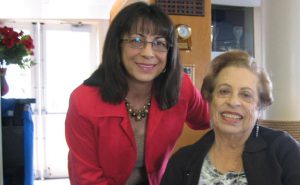Hispanic volunteers needed to aid in Alzheimer’s research

Frances Goodrich will do just about anything to recruit Hispanic participants into the program at the Shiley-Marcos Alzheimer’s Disease Research Center (ADRC).
The bilingual social worker for the ADRC is in charge of Hispanic outreach and is part of the leadership team for a Hispanic advisory committee.
She has placed literature at libraries, hair salons and bakeries. She has chatted up seniors and their caregivers in line at the grocery store, and while at the casino. She has walked the swap meet in National City with a stack of bilingual literature, talking to people about the importance of the center’s research.
“I always say anybody at arm’s length is a potential participant,” Goodrich said.
Under the umbrella of the University of California, San Diego’s medical school, the ADRC runs a number of research studies and clinical trials looking into the causes, treatment and prevention of Alzheimer’s disease.
Its primary study, funded by a federal grant, focuses on the pre-clinical and earliest stages of the disease in order to learn about its clinical development and pathology. The long-term study gathers information on the lives of people with mild cognitive impairment and mild to moderate dementia. An annual exam looks at the lifestyle and behavior of the volunteers, and includes a physical exam as well as a cognitive test on their memory. Participants also agree to an autopsy at death. Some volunteers also have the opportunity to take part in clinical trials.
ADRC has about 100 Hispanic participants in a pool of about 450. That’s not too far off from the demographics in San Diego, where about 30 percent of the population is Latino. However, in order to understand how differences in lifestyle choices and genetics impact the disease, the research center is striving to recruit more Hispanics.
“In order to find out more about changes in Latinos, we need to see them. We need to see people to get comparison data with non-Hispanics. We can’t do any of that without the numbers,” Goodrich said. However, there are obstacles to recruitment.
Transportation is a big one, according to Goodrich. Many Hispanics live in the South Bay, which means a bit of traveling to get to the research center’s La Jolla campus.
Another barrier is cultural. Latinos often have an inherent skepticism about research, said ADRC Program Director Mary Sundsmo. Hispanic seniors also may not have access to online information that might temper that skepticism, either because they don’t use computers or the information they find might not be in Spanish. And in underserved populations, it’s common to view Alzheimer’s as a natural part of aging, rather than a fatal disease.
“Hispanics are sometimes more reluctant, more afraid of research. We need to reassure them that it’s a good thing,” Sundsmo said. “Many Latinos may not recognize that memory problems may not be normal aging, but could be a major problem. Sometimes memory problems are caused by reversible factors and sometimes by Alzheimer’s disease. Because Latinos have such close family units, the family members simply provide in-home help without obtaining a diagnosis.”
ADRC tries to make participation easier for Hispanics by providing authorization forms in both English and Spanish, and it has three bilingual staff members to gather information from Spanish-speaking participants. The research center is also in discussions to partner with a clinic or facility in Chula Vista to make its research testing more convenient for families in the South Bay.
“We can’t study Caucasians and learn about Hispanics,” Sundsmo said. “A lot of the research is on whites. But especially in California, 40 percent of the population will be Hispanic in the near future. There’s a huge need for this research.”
Today more than 5 million Americans age 65 and older are living with Alzheimer’s disease. According to the Alzheimer’s Association, that figure could reach 7.1 million by 2025. The number of Hispanic elders with Alzheimer’s and related dementias could increase more than six-fold by 2050, from fewer than 200,000 today to as many as 1.3 million.
Hispanics are the fastest-growing population in the United States, and are about 1.5 more times more likely to develop Alzheimer’s disease than whites. Risk factors for vascular disease — mainly diabetes, high blood pressure and high cholesterol — may also be risk factors for Alzheimer’s and stroke-related dementia. Latinos in the United States have higher rates of diabetes, putting them at greater risk for developing Alzheimer’s.
Part of the challenge of recruitment is getting Latinos to see that by being part of the longitudinal study or a clinical trial, they are helping to move the research forward. Further, results of the evaluation are given to participants, so they can share it with their own doctors. Consultation with social workers and referrals are also available as needed.
Sundsmo and Goodrich both said that once Hispanics get in the program and become familiar with the center’s purpose, staff members and processes, they tend to stay in the study. Many participants have been involved between 15 and 18 years.
“Getting them in the door is the hard part,” Sundsmo said.
To that end, Goodrich’s next plan to reach out to the Latino community involves visiting senior housing centers to talk with residents about ADRC’s research and services. Her first stop will be the Congregational Towers in Chula Vista, where she will navigate the web site with them and answer any questions and concerns they might have.
“It’s difficult, and it’s a challenge, but I like a challenge,” Goodrich said. “I like finding new and innovative ways to reach them.”
Updated: July 20, 2015





